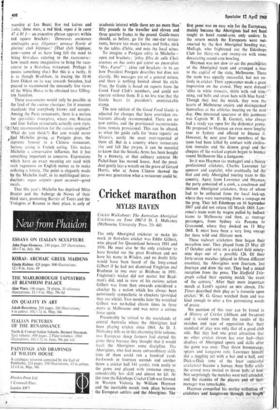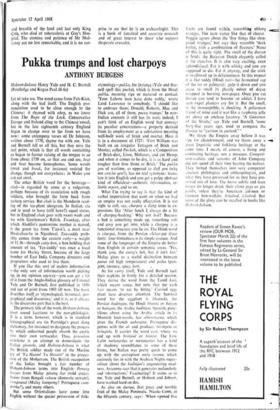Cricket marathon
MYLES RAVEN
The only Aboriginal cricketer to make his mark in first-class cricket was Eddie Gilbert, who played for Queensland between 1931 and 1936. He must also be the only cricketer to have bowled out the great Bradman and not have his name in Wisden, and no doubt little would have been heard of the long-armed Gilbert if he had not dismissed Fingleton and Bradman in one over at Brisbane in 1931. Fingleton's wicket did not matter but Brad- man's did, and in view of his curious action Gilbert was from then onwards considered a chucker by a nation which has always been notoriously sympathetic to chuckers (provided they are white). Two months later the wretched Gilbert was no-balled eleven times in three overs at Melbourne and was never a serious force again.
Presumably he retired to the wastelands of central Australia where the Aborigines had been playing cricket since 1864. As D. J. Mulvaney tells us in this charming little volume, two European sheep farmers had started the game there because they thought that it would teach the Aborigines some discipline. The Aborigines, who had many extraordinary skills (one of them could run a hundred yards backwards in fourteen seconds and another threw a cricket ball 141 yards), took easily to the game and played with immense energy, considerably less skill and almost no kit. At this time the Edenhope Cricket Club was formed in Western Victoria by William Hayman and the inevitable match took place between the European settlers and the Aborigines. The first game was an easy win for the Europeans, mainly because the Aborigines had not been taught to bowl round-arm, only unders. In the return Mitch the Europeans were out- smarted by the first Aboriginal bowling'star, Mullagh, who frightened out the Edenhope Club for thirty-six and twenty-six with some devastating round-arm bowling.
Hayman was. not slow to see the possibilities of the Aboriginal team and arranged a, tour to the capital of the state, Melbourne. There the team was equally successful, but not en- tirely in cricket. Their appearance made a great impression on the crowd. They were dressed `alike in white trousers, shirts with red
ming, red belts and straw hats with blue band.' Though they lost the match, they won the hearts of Melbourne society and distinguished'. themselves at the athletics meeting on the next'. day. One interested spectator at this jamboree.• ` was Captain W. E. B. Gurnett, who always' had a ready eye open for the dishonest penny. He proposed to Hayman an even more lengthy' tour to Sydney and offered to finance it. However, by next year four members of the team had been killed by contact with civilisa- tion (measles and the demon grog) and the cheques of the wicked captain begun to bOunce round Melbourne like a kangaroo; Soit was Hayman (as manager) and a Surrey professional cricketer, Charles Lawrenee IaS sponsor and captain), who eventually led the first and only Aboriginal touring team to this country. Apart from Lawrence and Hayman, the party consisted of a cook, a coachman and thirteen Aboriginal cricketers, three of whore had to be collected from the local lock-up; where they were recovering from a rampage on the grog. They left Edenhope on 16 September 1867 and did not return till March 1869. Law- rence's team went by wagon pulled by bullock teams to Melbourne and then, as steerage passengers, from Sydney via Panama to Gravesend, where they docked on 13 May 1868. It must have been a very long voyage for these wild and illiterate men.
These stalwart cricketers then- began their marathon tour. They played from 25 May till 17 October and were on a cricket field ninety- nine days out of a possible 126. Of their forty-seven matches (played in fifteen different counties), the Aborigines won fourteen, lost fourteen and drew the rest. They had a mixed reception from the press. The Sheffield Tele graph called their opening match 'the event • of the century.' After their most important match at Lord's against an MCC eleven, The Times described their play as 'a travestie upon cricket.' W. G. Grace watched them and was kind enough to utter a few patronising words of praise.
No _mention of this tour can be found in A History of Cricket (Altham and Swanton) and it would seem from the results of the matches and type of opposition that their standard of play was only that of a good club side. But they had one great attraction that no other cricket eleven has ever had—their displays of Aboriginal sports and skills after the game was over. They threw boomerangs, spears and kangaroo rats; 'Lawrence 'himself did a juggling act with a bat and a' ball, and Dick-a-Dick (one of the least successful • cricketers) became 'a human Aunt Sallyt while the crowd were invited to throw balls al-hittil"' Not surprisingly the matches were well attended,' and the stamina of the players and of their' ' manager was remarkable.
Hayman compelled his motley collection ,or- cricketers and hangers-on through the teng,"
and breadth of the land and lost only King Cole, who died of tuberculosis at Guy's Hos- pital The stamina and patience of Mr Mul- vaney are no less remarkable, and it is no sur- prise to see that he is an archaeologist. This is a book of fanatical and accurate research and of great interest to those who support desperate crusades.











































 Previous page
Previous page